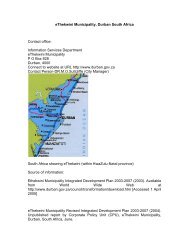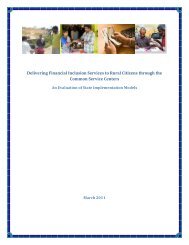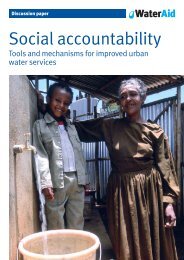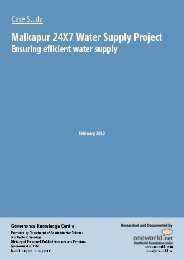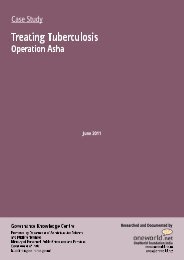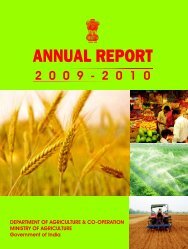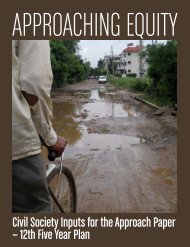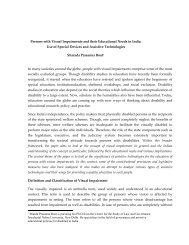See full case study - Indiagovernance.gov.in
See full case study - Indiagovernance.gov.in
See full case study - Indiagovernance.gov.in
- No tags were found...
You also want an ePaper? Increase the reach of your titles
YUMPU automatically turns print PDFs into web optimized ePapers that Google loves.
Governance Knowledge CentrePromoted by Department of Adm<strong>in</strong>istrative Reforms and Public GrievancesM<strong>in</strong>istry of Personnel, Public Grievances and PensionsGovernment of IndiaCase StudyUrban DevelopmentIn-Situ Slum Upgradation under JNNURMTRANSPARENCY AND ACCOUNTABILITYJanuary 2012choice. The community was encouraged to express their own wishes <strong>in</strong> terms of decid<strong>in</strong>g thelocation of toilets, provision of balconies and water tanks. Constant and cont<strong>in</strong>uous dialoguewith the community not only ensures people centric development but <strong>in</strong>stilled a sense ofownership for the project among the beneficiaries.Tenure security: More than the hous<strong>in</strong>g and sewage systems, the unparallel benefit of theproject for the beneficiaries has been the sense of tenure security. The project will allow thebeneficiaries hav<strong>in</strong>g a legal claim to their houses, where they have been liv<strong>in</strong>g for decades.Secure tenure is a basic condition for access to socio-economic opportunities such as livelihood,basic services under <strong>gov</strong>ernment welfare schemes and micro credit. Secure tenure work as an<strong>in</strong>centive for slum dwellers to improve their liv<strong>in</strong>g environment.CHALLENGES IN IMPLEMENTATIONThe Pune <strong>in</strong>-situ slum upgradation project has been successful <strong>in</strong> explor<strong>in</strong>g an alternatehous<strong>in</strong>g and slum upgradation model to be replicated across the country. Though this projectwas a collaborative effort of <strong>gov</strong>ernment, civil society and the community it encountered a fewchallenges <strong>in</strong> deal<strong>in</strong>g with vary<strong>in</strong>g needs of the community. Whenever the proposition ofshar<strong>in</strong>g land area with neighbours were discussed by the architect team, there was a strongresistance from the people. As very small houses (with less than 100 sq feet carpet area) had tobe <strong>in</strong>tegrated with the neighbours’ to come up with the G+2 structure, the households showeddis<strong>in</strong>terest and lack of trust <strong>in</strong> the project. It required months of persuasion and negotiationwith the community to start the actual process of construction. The question of f<strong>in</strong>ancialcontribution of 10 percent by the beneficiaries iaries was also a subject of contention. The project alsohad an objective of widen<strong>in</strong>g roads, build<strong>in</strong>g storm water dra<strong>in</strong>age system and <strong>in</strong>crease <strong>in</strong> thepublic space, which required for households to rearrange their footpr<strong>in</strong>ts. However, the appealfor releas<strong>in</strong>g some part of the foot pr<strong>in</strong>t emerged as a major cause of conflict lead<strong>in</strong>g to limit<strong>in</strong>gthe scope of the project to upliftment of hous<strong>in</strong>g conditions.1Researched and documented byOneWorld Foundation India




